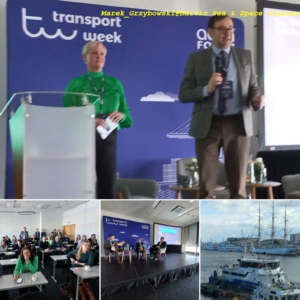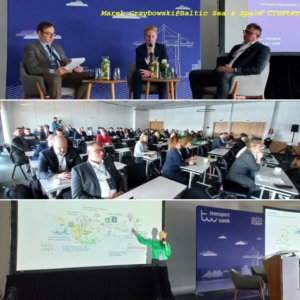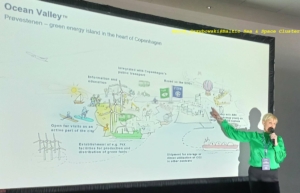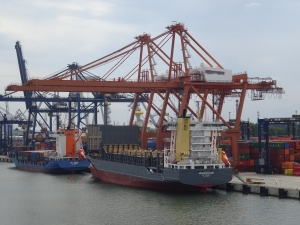Baltic Ports for Climate – a determined approach to ambitious goals


By Marek Grzybowski, Maritime Journalist Club BSSC
The first edition of the Baltic Ports for Climate took place today during the Transport Week 2023 conference in Gdynia, Poland. The event, organized in cooperation with the Baltic Ports Organization (BPO) and attended by nearly 100 participants focused on the Baltic ports’ approach to climate responsibility.
It won’t come a surprise to most experts from all the corners of the maritime industry that new environmental regulations and policies, introduced by the policymakers at a very brisk pace, are one of the main factors impacting the development of the sector. As of right now, average annual emissions from maritime transport worldwide equate to 2.5% of global CO2 emissions. At the same time, 80% of the world’s commodities are transported by sea. The EU is set to lead the charge in reducing the level of emissions from maritime transport and the number of recently introduced regulations shows clearly that they are not joking around.
Dariusz Kryczka (EY) described the pace of the introduction of new regulations and policies not as an evolution but a revolution and it seems a very apt characterization. With FuelEU Maritime, AFID/AFIR, and the inclusion of shipping in EU ETS on the horizon (just to name a few), the time for preparation is there but it is short and requires the industry to act now. Just to give an example, companies will have to submit to the verifiers a monitoring plan for each of their ships by August 31st, 2024, as part of FuelEU Maritime. The regulation itself is set to come into force on January 1st, 2025. The successful implementation of these regulations hinges on rapid technological and infrastructural development. And this will require both money and time.
Baltic ports at the forefront of change
More deadlines are just years away. The Alternative Fuel Infrastructure Regulation (AFIR) will require ports to provide shore-side power supply for container and passenger ships by 2030. And just as the EU is one of the main driving forces behind the introduction of these initiatives, the Baltic ports may serve as role models for preparedness. According to Bogdan Ołdakowski (BPO), there are already well over 20 on-shore power supply (OPS) installations operational in the Baltic, with nearly 10 more on their way.
The BPO is deeply involved in supporting the region in such endeavors, as illustrated by its latest project and the namesake of the event – Baltic Ports for Climate. The project aims to further the development and construction of additional OPS systems in Baltic ports by bringing together experts and stakeholders to create a platform for the exchange of expertise and knowledge already gained during successful implementation of existing projects. The project will also consider the differing needs and characteristics of core and comprehensive ports, differentiating the approach between them. Baltic Ports for Climate application has been successfully delivered to CINEA at the beginning of 2023. More information is available upon contacting the BPO Secretariat.
Patrik Hellman (Port of Kaskinen) delivered a very important remark regarding the financial side of meeting the demands set by regulators. The regulations introduced by policymakers are not market driven, and rarely take into account the ports’ take on actual costs involved. Furthermore, the technological uncertainty is very much an issue that needs to be carefully considered when planning such overarching regulations.
Patrik was also part of the discussion on ports’ in-house green initiatives, giving a brief summary of the Port Activity App, tool in use on a national level by Finnish ports, allowing for optimization of vessel traffic and port operations optimization. A unique feature of the app is that it’s built with data sharing in mind. Ports have access to each other’s data allowing for an even greater level of vessel call prediction.
The panel was joined by Daria Mróz (Port of Gdynia), who briefed the audience on CO2 mapping. It allowed Gdynia’s seaport to pinpoint the main sources for CO2 emissions, namely vessel operations and electricity and heat consumption. This in turn enables the port to develop an emission reduction strategy tailored to its unique characteristics, ensuring the most bang for buck and limiting the risk of asset waste.
Defining climate responsibility


The path to carbon neutrality is not an easy one, but some of the Baltic ports have already made great strides towards this ambitious goal and even are on the verge of achieving it. The Copenhagen Malmö Port, represented by Ulrika Prytz Rugfelt (CMP), aims to become carbon neutral as soon as 2025. One of the actions that allowed the port to get within reach of this goal was the switch from fossil fuels to bio-diesel for all machines operating within the Swedish part of the port. Copenhagen is set to follow shortly after the completion of the new container terminal.
This part of the rich portfolio of green actions undertaken by CMP is mirrored by others. Jan Jarmakowski (GCT) also mentioned the switch from diesel to green fuels in context of powering GCT terminal’s machinery. The company is also looking towards other possible energy sources, such as Hydrogen but the technology seems still not mature enough for commercial use and will take a couple more years to be viable.
Given the broad scope of challenges faced by today’s ports, it is reassuring that there are many tools at their disposal. The complexity and multi-faceted character of port operations, mean that over decades they have naturally been amassing big amounts data available to them. Dr Stefan Leschka (DHI) demonstrated how this data can be combined and employed to develop models adding port authorities in the decision-making process, improving efficiency and minimizing risk factors.
OPS returned as a topic later during the day, with Björn Boström (Port of Ystad) stating firmly that it should always be prioritized as a solution contributing to reduction of greenhouse gas (GHG) and noise pollution. Yet it needs to be approached as any other business case, with careful consideration of costs involved. The case of the Swedish port shows that OPS holds its ground as feasible even given the increase in traffic and vessel size. Tommaso Spanevello (HAROPA PORT) added that it is also vital that the legal framework governing the implementation of OPS takes variable demand and supply into account. Another point he touched upon was the growing pressure ports face not just from policymakers but also their customers. It seems that environmental awareness has firmly embedded itself in our culture.
